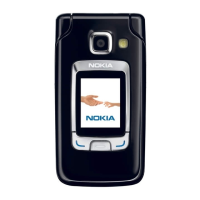Copyright © 2007 Nokia. All rights reserved.
Call functions
28
Share video
To receive a sharing session, the recipient must install
Video sharing and configure the required settings on
their mobile device. You and the recipient must both be
registered to the service before you can start sharing.
To receive share invitations, you must be registered to the
service, have an active UMTS connection, and be within
the UMTS network coverage.
Live video
1 When a voice call is active, select Options > Share
video > Live video.
2 The phone sends the invitation to the SIP address you
have added to the contact card of the recipient.
If the recipient has several SIP addresses in the contact
card, select the SIP address to which you want to send
the invitation, and Select to send the invitation.
If the SIP address of the recipient is not available,
enter a SIP address. Select OK to send the invitation.
3 Sharing begins automatically when the recipient
accepts the invitation.
The loudspeaker is active. You can also use a headset
to continue your voice call while you share live video.
4 Select Pause to pause the sharing session. Select
Continue to resume sharing.
5 To end the sharing session, select Stop. To end the
voice call, press the end key.
Accept an invitation
When someone sends you a share invitation, an invitation
message is displayed showing the sender’s name or SIP
address. If your device is not set to Silent, it rings when
you receive an invitation.
If someone sends you a share invitation and you are not
within UMTS network coverage, you will not know that you
received an invitation.
When you receive an invitation, select Accept to begin the
sharing session, or Reject to decline the invitation. The
sender receives a message that you rejected the invitation.
You can also press the end key to decline the sharing
session and disconnect the voice call.
To end the sharing session, select Stop.
Log
In the log, you can monitor phone calls, text messages,
packet data connections, and fax and data calls registered
by the phone.
Connections to your remote mailbox, multimedia
messaging center, or browser pages are shown as data
calls or packet data connections in the general
communications log.

